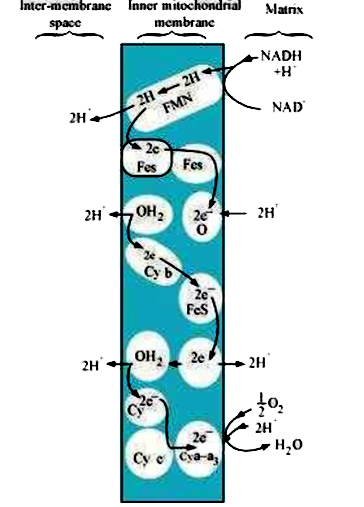ELECTRON TRANSPORT SYSTEM (ETS) AND OXIDATIVE PHOSPHORYLATION
Video Solution
Text Solution
ETS or electron transport system is located in the inner mitochondrial membrane. It helps in releasing and utilizing the energy stored in NADH+H+ and FADH2.NADH+H+, which is formed during glycolysis and citric acid cycle, gets oxidized by NADH dehydrogenase (complex I). The electrons so generated get transferred to ubiquinone through FMN. In a similar manner, FADH2 (complex II) generated during citric acid cycle gets transferred to ubiquinone. The electrons from ubiquinone are received by cytochrome bc1 (complex III) and further get transferred to cytochrome c. The cytochrome c acts as a mobile carrier between complex III and cytochrome c oxidase complex, containing cytochrome a and a3, along with copper centres (complex IV).
During the transfer of electrons from each complex, the process is accompanied by the production of ATP from ADP and inorganic phosphate by the action ATP synthase (complex V). The amount of ATP produced depends on the molecule, which has been oxidized. 2 ATP molecules are produced by the oxidation of one molecule of NADH. One molecule of FADH2, on oxidation, gives 3 ATP molecules.

|
Updated on:21/07/2023
Topper's Solved these Questions
Similar Questions
Knowledge Check
- Question 1 - Select One
Terminal oxidation in ETS is
Astoppage of oxidationBfinal release of protonsConly step where actual oxidation using O2 occursDETS initiation - Question 2 - Select One
Electron Transport System (ETS) is located in mitochondrial
AOuter membrane,BInter membrane spaceCInner membraneDMatrix - Question 3 - Select One
Electron Transport System (ETS) is located in mitochondrial
AOuter membraneBInter membrane spaceCInner membraneDMatrix
Electron Transport System (ETS) is located in mitochondrial
View SolutionElectron Transport system (ETS) is located in mitochondrial
View SolutionAssertion : The metabolic pathway through which the electron passes from one carrier to another is called the electron transport system (ETS)
Reason : ETS is present in the inner mitochondrial membrane.View SolutionETS (electron transport system) is found in
View SolutionIn electron transport system (ETS) which of the following cytochromes reacts with oxygen
View Solution

